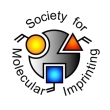Authors: Jetzschmann KJ, Jágerszki G, Dechtrirat D, Yarman A, Gajovic-Eichelmann N, Gilsing HD, Schulz B, Gyurcsányi RE, Scheller FW
Article Title: Vectorially Imprinted Hybrid Nanofilm for Acetylcholinesterase Recognition.
Publication date: 2015
Journal: Advanced Functional Materials
Page numbers: n/a.
DOI: 10.1002/adfm.201501900
Abstract: Effective recognition of enzymatically active tetrameric acetylcholinesterase (AChE) is accomplished by a hybrid nanofilm composed of a propidium-terminated self-assembled monolayer (Prop-SAM) which binds AChE via its peripheral anionic site (PAS) and an ultrathin electrosynthesized molecularly imprinted polymer (MIP) cover layer of a novel carboxylate-modified derivative of 3,4-propylenedioxythiophene. The rebinding of the AChE to the MIP/Prop-SAM nanofilm covered electrode is detected by measuring in situ the enzymatic activity. The oxidative current of the released thiocholine is dependent on the AChE concentration from »0.04 x 10-6 to 0.4 x 10-6 M. An imprinting factor of 9.9 is obtained for the hybrid MIP, which is among the best values reported for protein imprinting. The dissociation constant characterizing the strength of the MIP-AChE binding is 4.2 x 10-7 M indicating the dominant role of the PAS-Prop-SAM interaction, while the benefit of the MIP nanofilm covering the Prop-SAM layer is the effective suppression of the cross-reactivity toward competing proteins as compared with the Prop-SAM. The threefold selectivity gain provided by i) the "shape-specific" MIP filter, ii) the propidium-SAM, iii) signal generation only by the AChE bound to the nanofilm shows promise for assessing AChE activity levels in cerebrospinal fluid
Author keywords: acetylcholinesterase, biomimetic sensors, molecularly imprinted electropolymers, peripheral anionic site, propidium



Join the Society for Molecular Imprinting

New items RSS feed
Sign-up for e-mail updates:
Choose between receiving an occasional newsletter or more frequent e-mail alerts.
Click here to go to the sign-up page.
Is your name elemental or peptidic? Enter your name and find out by clicking either of the buttons below!
Other products you may like:
 MIPdatabase
MIPdatabase









